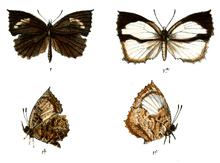Miletographa drumila
| Crenulate Darkie | |
|---|---|
 | |
| Scientific classification | |
| Kingdom: | Animalia |
| Phylum: | Arthropoda |
| Class: | Insecta |
| Order: | Lepidoptera |
| Family: | Lycaenidae |
| Genus: | Miletographa |
| Species: | M. drumila |
| Binomial name | |
| Miletographa drumila (Moore, 1865) | |
The Crenulate Darkie (Miletographa drumila)[1] is a small butterfly found in India that belongs to the Lycaenids or Blues family.
Description
Male upperside: earthy brown. Fore wing: costa at base and a broad outward discal streak from beyond apex of cell curved downwards towards but not reaching the tornal angle, dull white, diffuse at the edges ; apex and termen broadly very dark blackish-brown. Hind wing: costal margin above the subcostal vein and in a line with it up to the termen similarly very dark blackish-brown, the rest of the brown colour uniform without any white. Underside, fore wing: dull pale brown, costal margin and disc mottled with small catenulated spots of dark brown; cell with three short transverse bars of dark brown, the middle bar extended below the cell but not reaching the dorsum; a white curved discal band as on the upperside, but obscure, diffuse and ill-defined, merged with a pale area along the middle of the dorsum; termen broadly margined with dark rusty brown that has more or less of a mottled appearance. Hind wing: dull pale brown thickly mottled with catenulated spots and strigeo of dark rusty brown; catenulated, somewhat broken, transverse irregular bands of the latter colour cross the base, middle and apex of the cell; a similar short band is placed at right angles to the dorsal margin and curving slightly upwards terminates at vein 3. Antennae dark brown; head, thorax and abdomen rusty brown; beneath: the palpi, thorax and abdomen narrowly whitish.
Female upperside : white. Fore wing: apical, terminal and tornal areas black, the inner margin of the black commences just before the middle of the costa, and runs obliquely outward in a sinuous curve to base of the apical fourth of vein 2, thence it is produced for a short distance inwardly along that vein and terminates at the middle of the dorsal margin. Hind wing: a broad black stripe along the costal margin; the termen somewhat narrowly pale yellowish-brown. Underside white, the markings somewhat variable. Fore wing: costa, apex and termen with minute earthy-brown speckles, sparse along the costa, more dense on the termen; on the latter they coalesce and form a brown smudgy border that is bounded on the inner side by a curved, postdiscal, more or less clearly defined, narrow, yellowish-brown band; cell crossed transversely by a basal, a medial and an apical short similar band; the medial band darkened in colour and continued almost to the dorsum, the apical band along the discocellulars. Hind wing: with minute brown speckles, more or less lightly and irregularly stained with rusty brown; basal half with obscure, transverse, narrow, macular, earthy-brown bauds that are well-defined only anteriorly, the basal one produced up to the dorsum; a short dark-edged transverse band from tho tornus to vein 4 running parallel to the costal margin, the lower edge of the band acutely and irregularly dentate; the terminal and tornal areas below this band washed with earthy brown. Antenna, head, thorax and abdomen as in the male but very much paler.[2]
Taxonomy
This species is also considered as belonging to genus Allotinus. The same ref considers taxon (Allotinus) multistrigatus as conspecific to this species.[3]
Cited references
- ↑ Card for species drumila in LepIndex. Accessed 23 March 2007.
- ↑ Bingham, C. T. 1907. Fauna of British India. Butterflies. Volume 2
- ↑ Page on Marrku Savela's site for genus Allotinus (Lycaenidae).
See also
References
- Bingham, C. T. (1907) Fauna of British India including Ceylon and Burmah - Butterflies. Vol. II., (ed. 1).
- Evans, W.H. (1932) The Identification of Indian Butterflies. 2nd Ed, (i to x, pp454, 9 figs, Plates I to XXXII), Bombay Natural History Society, Mumbai, India.
- Wynter-Blyth, M.A. (1957) Butterflies of the Indian Region, Bombay Natural History Society, Mumbai, India.
Online
- Beccaloni, G. W., Scoble, M. J., Robinson, G. S. & Pitkin, B. (Editors). 2003. The Global Lepidoptera Names Index (LepIndex). World Wide Web electronic publication. (accessed 26 September 2007).
- Savela, Marrku Website on Lepidoptera (accessed 26 September 2007)
External links
| Wikimedia Commons has media related to Allotinus drumila. |